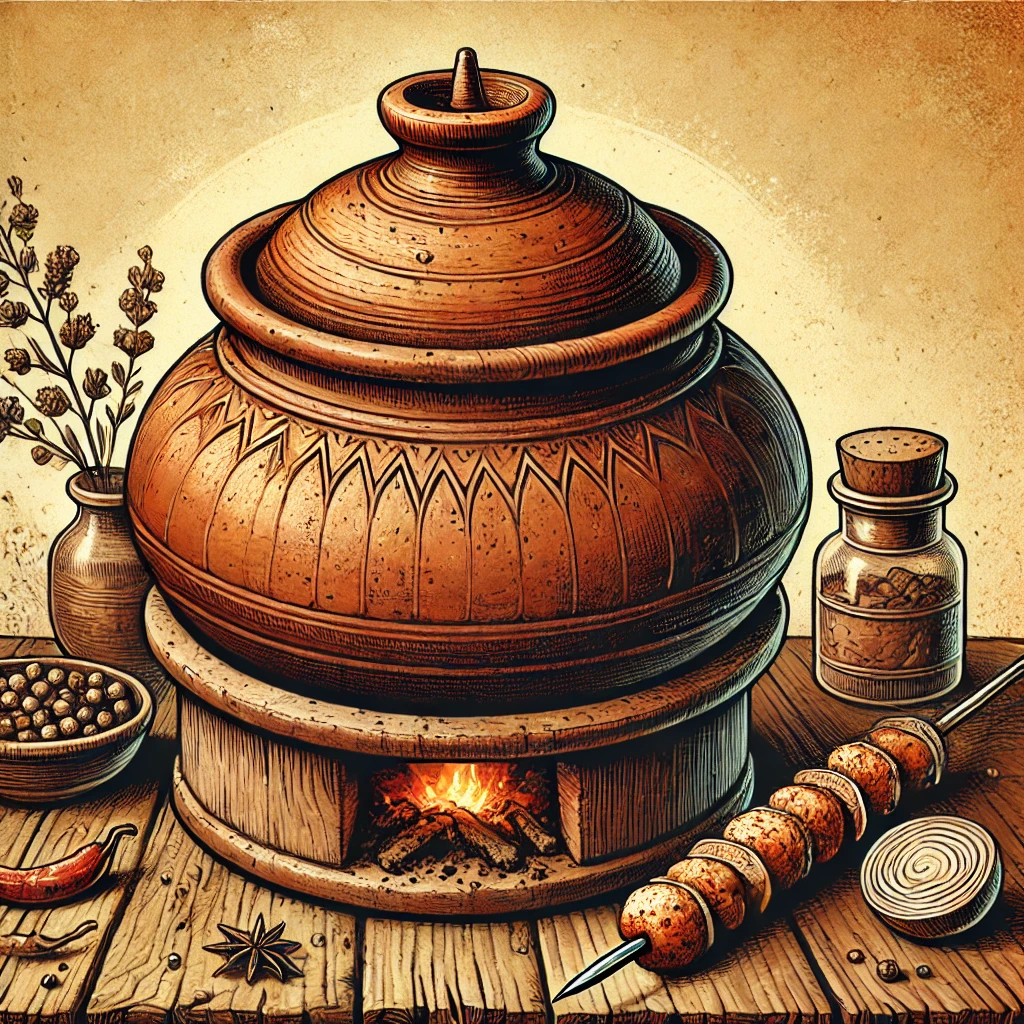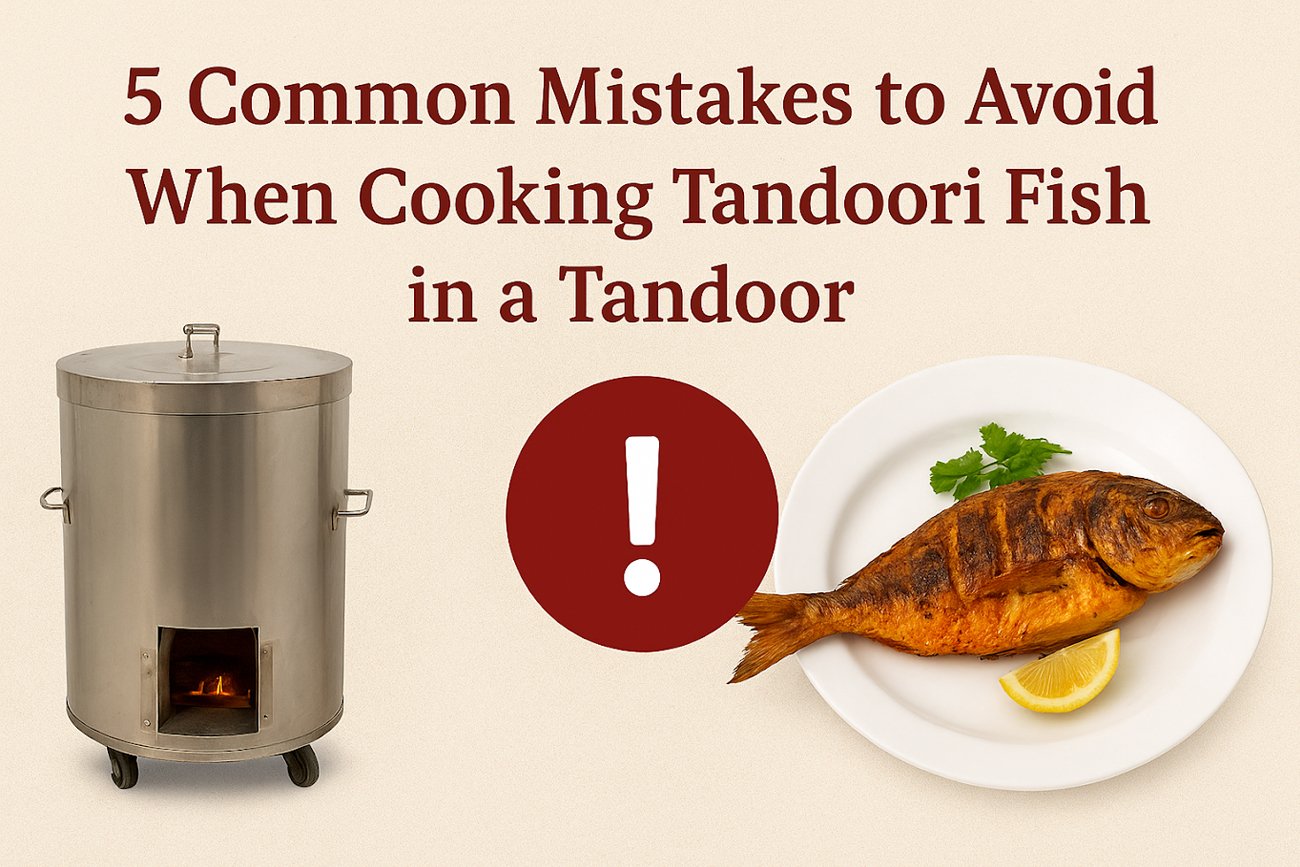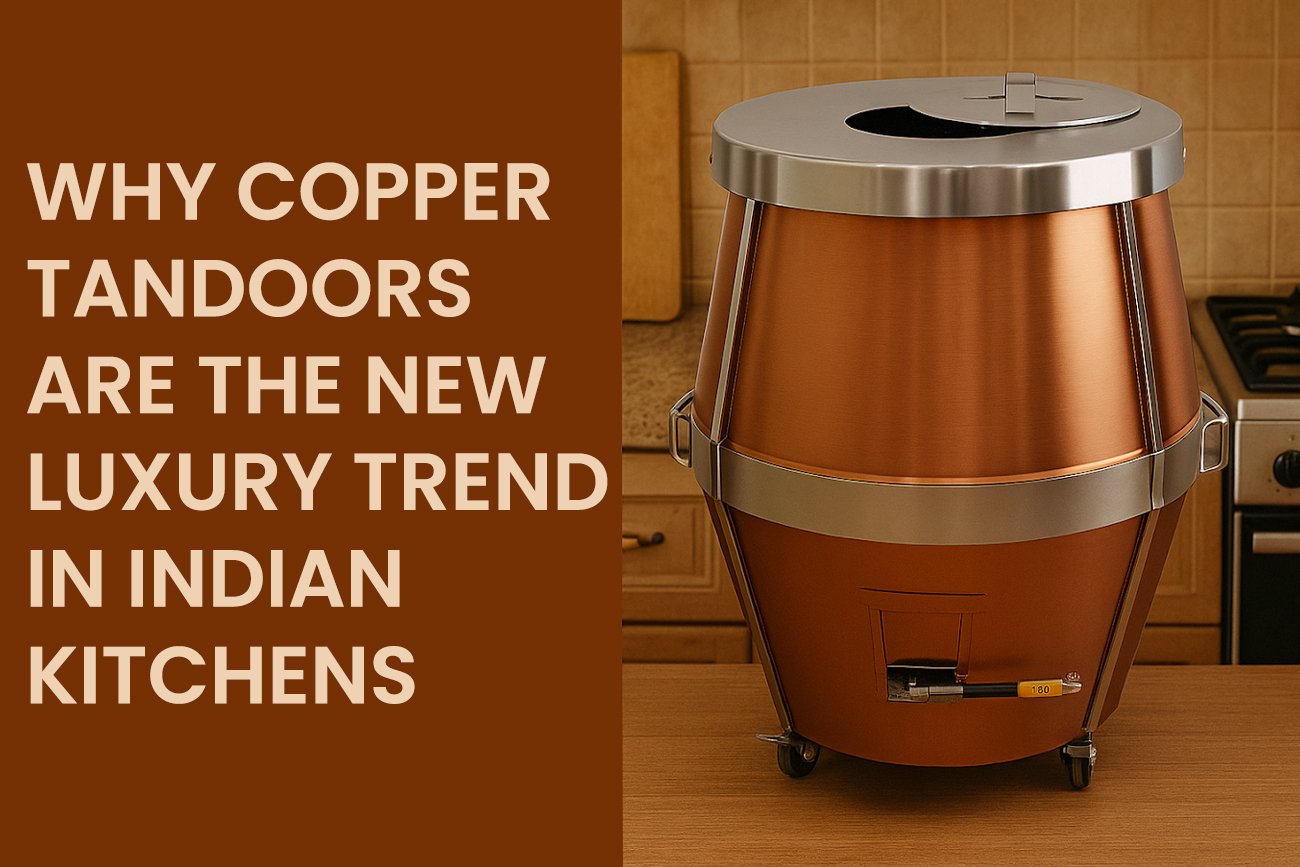
The Timeless Tandoor: A Tradition Shaped by Fire, Clay, and Flavor
The tandoor is not just an oven; it is a symbol of tradition, culture, and culinary excellence. With its distinctive barrel shape and roots in ancient cooking methods, the traditional oven has become the heart of Indian grilling and an essential part of the cuisine. Traditionally crafted from fine clay and reinforced with natural materials like grain husks and animal hair, it is a fascinating combination of art and utility.
Whether in a small Indian restaurant in your neighborhood or in luxurious dining spots from New Delhi to London, the clay oven plays a crucial role in creating flavorful dishes. It produces foods with a unique char and smoky taste that you can’t achieve with regular ovens. Let’s dive into the story of the Clay Pot Ovens, its history, how it is made, and how it has evolved over time.
The Origins: Where the Tandoor Began
The tandoor has a fascinating history, with its roots stretching back to the Persian tanoor or tannur ovens used in ancient times. Many food historians trace the oven’s origins to northern Persia, now known as Iran. From Persia, the idea of cooking with clay ovens spread across Central Asia and eventually reached northern India.
When the clay pot oven arrived in India, it was primarily used for baking bread, a staple in the diet. It soon became a part of everyday life, and over the centuries, it developed into a versatile cooking method used to prepare a variety of dishes, from bread and meats to fish and even desserts.
Although tandoors weren’t originally part of India’s ancient culture, they have become an iconic cooking tool, especially in the northern regions. Today, northern India is known for producing some of the world’s best clay ovens, thanks to the skills and craftsmanship of local artisans who have been mastering the art for generations.
The Craftsmanship Behind the Clay Pot Oven
Creating a tandoor is an art form in itself. Skilled craftsmen, known as Kumhars, make these ovens by hand. They use a special type of clay that does not contain sand and is mixed with a type of grass known as munji to make it more durable. This ancient technique has been passed down from generation to generation, ensuring that the quality and authenticity remain unchanged.
The process of making a tandoor involves several steps:
Step 1: Creating the Base
The craftsmen start by preparing the clay mixture and forming it into slabs about 120-150mm wide, 500-600mm long, and 20-30mm thick. They then sift dry clay over the slab and roll it into a cylinder shape, which unfolds into a semicircle. Several such cylinders are spread out to create a ring that forms the base of the tandoor.
Step 2: Building the Structure
After forming the base, they pinch the top part of the ring to create a small notch and let it dry overnight. This makes it strong enough to support the weight of the next ring that will be added.
Step 3: Layering the Rings
Once the base has dried, the next ring is placed on top, connecting it smoothly to the previous one, especially at the notched part. This process continues, with more rings being added until the tandoor reaches the desired height.
Step 4: Shaping the Mouth
The final section, known as “The Mouth,” is hand-twisted to shape the top like the neck of a jug. This unique shape helps to concentrate the heat inside the oven, which is crucial for achieving the high temperatures required for cooking in a tandoor.
Step 5: Finishing Touches
Before the tandoor is ready for use, it is reinforced with a stainless steel belt around the rim to add strength. It is then wrapped in jute for extra protection during transportation and installation. The oven is left to dry in the open air before it is finally ready to be placed in the ground, a metal casing, or even mounted on a restaurant counter.
The Evolution of the Tandoor: From Bread Baking to Grilling Delights
The tandoor has come a long way since its early days of bread baking. While it started as a simple oven for making flatbreads like naan and roti, its use has expanded significantly. In the 19th century, cooks in Peshawar, a city in what is now Pakistan, began using the tandoors for grilling meats. This innovation changed the way the tandoor was used, making it a versatile cooking tool for a variety of dishes.
Peshawari cooks threaded pieces of chicken, lamb, and vegetables onto long skewers and marinated them in spiced yogurt. They then grilled the skewered food inside the clay oven, allowing the high heat to cook the meat quickly while retaining its juices. It became famous for its ability to make meat juicy and tender, with a delicious charred exterior.
The Versatility of the Cooking Tandoor: From Meats to Breads and More
Today, the tandoor Oven is used to prepare a wide range of dishes, both in traditional Indian cooking and in modern culinary creations. Let’s explore some of the most popular dishes cooked in a tandoor:
Tandoori Chicken
Perhaps the most famous dish cooked in a tandoor oven, tandoori chicken involves marinating the chicken in a mixture of yogurt and spices like turmeric, cumin, and garam masala. The marinated chicken is then placed on long skewers and cooked inside the tandoor. The high heat cooks the chicken quickly, giving it a smoky flavor and a slight char on the outside while keeping the inside juicy.
Naan and Other Breads
The tandoor is also ideal for making various types of bread, including naan, roti, and paratha. The dough is shaped and slapped against the hot walls of the tandoor, where it sticks and cooks quickly. The result is a soft bread with a slightly crisp crust and a distinct smoky taste. Naan is often brushed with butter or garlic and served alongside tandoori meats.
Fish Tikka
Another popular dish cooked in the tandoor oven is fish tikka. Chunks of fish are marinated in a mixture of yogurt, lemon juice, and spices, then threaded onto skewers and grilled. The intense heat of the tandoor cooks the fish quickly, ensuring it remains moist and flavorful.
Seekh Kebabs
Seekh kebabs are minced meat skewers that are flavored with herbs and spices. The minced meat is shaped around metal skewers and cooked inside the tandoor, where it develops a smoky, charred exterior while remaining tender inside.
The Secret Behind the Flavor: Why Tandoori Dishes Taste So Good
The magic of Traditional cooking lies in the high heat and the clay walls of the oven. When the oven is heated with charcoal or wood, the temperature inside the oven can reach up to 900°F (480°C). This intense heat cooks the food quickly, sealing in the juices and creating a crispy exterior. The clay walls also add an earthy flavor to the food, which is difficult to replicate in regular ovens.
The quick cooking process also helps retain the natural flavors of the ingredients, allowing the spices to infuse deeply into the meat or bread. This makes tandoor cooking a healthier option, as it requires minimal use of oil while still achieving a rich flavor.
Refinements from Peshawar: How the Tandoor Evolved for Meat Cooking
In Peshawar, cooks took tandoor cooking to the next level by introducing metal skewers. These long, sturdy skewers allowed them to cook a variety of meats, such as lamb, chicken, and even sausages, inside the tandoor. The idea was simple yet effective: the skewers held the meat in place while the intense heat of the clay oven cooked it to perfection.
Cooks in Peshawar also developed new ways to marinate the meats, using a mixture of yogurt, herbs, and spices. The yogurt helped tenderize the meat, while the spices added layers of flavor. To finish, they would brush the meat with ghee or butter, which would sizzle and smoke in the high heat, adding even more depth to the flavor.
The Tandoor Today: A Modern Kitchen Essential
The tandoor has come a long way from its traditional roots. Today, it is not only a feature in Indian restaurants but also in many home kitchens around the world. Modern tandoors come in various shapes and sizes, designed to meet different cooking needs. While some are still made from clay, others are crafted from stainless steel and feature built-in temperature controls to make them more user-friendly.
Whether you’re cooking in a small apartment kitchen or a large restaurant, there is a tandoor to suit your needs. From portable clay ovens to built-in tandoors that fit seamlessly into a countertop, the choices are endless. The modern tandoor continues to evolve, incorporating new materials and technologies while still retaining the traditional cooking methods that make it so special.
Availability of Tandoors: Where You Can Find One
If you’re looking to buy a tandoor, you will find many options available. In northern India, traditional clay tandoors are still made by skilled craftsmen using time-tested methods. These ovens are great for those who want an authentic cooking experience.
For international buyers, companies like Tandoor Morni offer a wide range of tandoors that are specially designed for different climates and cooking habits. For instance, tandoors made for Canada or the USA are often built to withstand colder weather and come with extra insulation. In contrast, tandoors for the Middle East might be designed to handle higher temperatures.
Different Types of Tandoors Available at Tandoor Morni
Tandoor Morni offers a variety of tandoors, including standard and custom sizes to meet your needs. Here are some of the common types available:
Standard Tandoors
Standard tandoors come in a range of sizes, from a 10-inch mouth to a 17-inch mouth, with a diameter of up to 12 inches and a height of 37 inches. These are suitable for both commercial use in restaurants and domestic use at home.
Custom Tandoors
If you have specific requirements, custom tandoors can be made to order. Whether you need a larger oven for a restaurant or a smaller one for personal use, Tandoor Morni can create a tandoor that fits your exact specifications.
Safe Packaging and Delivery
When you order a tandoor from Tandoor Morni, you can rest assured that it will arrive safely. The company uses a unique packaging system that includes special jute wrapping to protect the tandoor during shipping. This ensures that your tandoor reaches you in perfect condition, whether it’s being shipped by sea or air.
How to Use a Tandoor at Home
If you’re new to using a tandoor, here are some tips to get started:
-
- Preheat the Tandoor: Start by heating the tandoor for at least 30 minutes. Use charcoal or wood for an authentic flavor, or gas if you have a modern tandoor with a built-in gas burner.
-
- Prepare Your Ingredients: While the tandoor heats up, marinate your meats, prepare the dough for naan, or get your vegetables ready. A yogurt-based marinade works well for meats, while a simple butter and garlic mixture can enhance the flavor of naan.
-
- Use the Right Skewers: Thread your meats or vegetables onto metal skewers and place them inside the tandoor. For breads, you can use a special hook to stick the dough to the walls of the oven.
-
- Monitor the Cooking: Keep an eye on your food, as cooking times can vary depending on the heat and the size of the tandoor. Most foods cook quickly in a tandoor, so it’s important not to leave them unattended.
-
- Serve Hot: Remove the food once it’s cooked, brush with butter or ghee if desired, and serve immediately to enjoy the full flavor and texture.
Caring for Your Tandoor
Proper care can extend the life of your tandoor. Here are some maintenance tips:
- Clean It Regularly: After each use, remove any leftover ash and debris from the bottom of the tandoor. This helps maintain proper airflow for the next time you use it.
- Protect It from the Elements: If your tandoor is outdoors, cover it with a weatherproof cover when not in use to prevent damage from rain or extreme temperatures.
- Inspect for Cracks: Check the clay for any cracks, especially after long periods of use. Small cracks can be repaired with a clay mixture, while larger cracks may require professional attention.
Tandoor Cooking: An Experience Like No Other
Cooking with a tandoor is more than just preparing a meal; it’s a sensory experience. The aroma of spices, the sight of flames licking the walls of the oven, and the sound of sizzling meat make for an unforgettable cooking process. When you use a tandoor, you connect with a tradition that has been passed down for thousands of years. It’s an experience that brings people together, whether you’re hosting a backyard barbecue or running a restaurant kitchen.
The tandoor is not just an oven; it’s a way of life. It invites you to slow down, enjoy the process, and savor the flavors that only a clay oven can provide. So, whether you’re a seasoned chef or a home cook looking to try something new, adding a tandoor to your cooking repertoire will open up a world of delicious possibilities.
Visit Tandoor Morni to Explore Our Range of Tandoors
If you’re ready to experience the magic of tandoor cooking, check out Tandoor Morni’s selection of high-quality tandoors at tandoormorni.com. We offer a variety of options to suit both home cooks and professional chefs. Enjoy the rich flavors and authentic taste that only a tandoor can deliver. Order your tandoor today and bring the timeless tradition of tandoori cooking into your kitchen!
Need Help? Order and Technical Support
Have questions or ready to place an order? Reach out to us via phone at +1(727) 251 6924 or email us at info@tandoormorni.com.
Need detailed instructions? Explore the Operation Manual for our CH & CS models to get started with your Tandoor oven today.
Common Queries – FAQ’S
Can I use a tandoor Indoors?
Yes, certain tandoor models are designed for residential use, including compact, home-friendly versions. However, using a tandoor indoors requires proper ventilation and adherence to safety precautions to manage high heat and potential smoke. Always consult the manufacturer’s guidelines to ensure safe indoor use. For best results, they are often used in well-ventilated spaces or outdoors.
Are Tandoor-Cooked Foods Healthy?
Yes, tandoor-cooked foods are often considered healthy because they typically require little to no oil. The high cooking temperatures allow the food to cook quickly, preserving nutrients while reducing the need for additional fats. Additionally, the vertical cooking method allows excess fats to drip away, resulting in leaner dishes.
What Types of Fuel Can Be Used in a Tandoor?
Tandoors can be heated using charcoal, wood, natural gas or propane. Charcoal and wood provide an authentic smoky flavor, while natural gas or propane is more convenient and easier to control. The choice of fuel often depends on the specific cooking requirements and local regulations, especially in commercial settings.
How Does a Tandoor Oven Differ from a Conventional Oven?
Unlike conventional ovens, which use electric or gas heat, a tandoor is made from clay and uses charcoal, wood, or gas to heat the walls. The cylindrical shape and porous clay walls create an environment where heat circulates evenly, cooking food quickly while adding a smoky flavor. Conventional ovens, in contrast, lack the intense heat and unique cooking technique of a tandoor.
How Much Maintenance Does a Gas Tandoor Require?
Gas Tandoor needs regular maintenance, though less than Charcoal Tandoor models. Here’s a breakdown:
- Daily Maintenance: Wipe down the inner chamber and clean the burner.
- Weekly Maintenance: Check the burner and gas line for any blockages or leaks.
- Monthly Maintenance: Deep clean the gas pipes, burners, and inner chamber.
- Quarterly Maintenance: Have a professional inspect the gas connections and burners.
- Annual Maintenance: Perform a full inspection and reapply clay lining if needed.
Avoid exposing the tandoor to excessive water, and gradually increase heat to prevent cracks.
How Can I Make a Payment for My Tandoor Order?
You can pay for your tandoor order through our website by placing an online order using the available payment options. If you prefer to place an order over the phone, we accept payment via Zelle for a quick and secure transaction.
Which Tandoor Oven Size Should I Choose?
- For Home Use: Consider the number of family members or guests you typically serve. A mini tandoor is ideal for smaller gatherings.( Suggested Product: R26 )
- For Restaurants: Measure the entrance to ensure the oven fits through the door. Select a size based on available space and cooking needs. (Suggested Product: CH02)
- For Naan Bread: Opt for an oven with a smaller mouth opening, resulting in a more egg-shaped clay pot, perfect for naan preparation. For larger meat portions, choose a bigger oven to maintain heat longer. (Suggested Product: CH04)
- For Catering: A Clay Tandoor Oven is suitable for catering due to its lightweight and easy transport features. (Suggested Product: CS01)
- For Banquet Halls: A larger oven with a spacious clay pot is ideal for preparing multiple dishes quickly during big events. (Suggested Product: CH06)
- For Open Kitchens or Outdoor Patios: Choose a model with a decorative finish, such as a copper tandoor, to enhance the kitchen’s appearance with a touch of elegance. (Visit Our Copper Tandoor).
What Should You Consider When Installing a Restaurant Clay Oven?
- When installing a tandoor in your restaurant kitchen, consider the following:
- Space and Placement: Ensure there is enough clearance around the tandoor for ventilation and safety, with fireproof or heat-resistant flooring.
- Ventilation and Exhaust: Proper ventilation is essential to handle heat and smoke, especially with charcoal tandoors.
- Safety Measures: Use heat-resistant barriers if the tandoor is near other equipment, and keep fire safety equipment like extinguishers handy.
- Fuel Supply: Decide between charcoal, which offers traditional flavors, and gas, which is easier to manage.
By keeping these points in mind, you can ensure a safe and efficient tandoor setup. If you're looking for a Restaurant Clay Oven for Sale, make sure to choose a model that fits your kitchen's requirements and meets all necessary safety standards.
- Menu Considerations: Larger tandoors or multiple units may be needed if you have a diverse menu or high demand during peak hours.
- Maintenance and Cleaning: Clean the tandoor daily and monitor for any wear or damage to the clay or gas parts.
- Compliance with Regulations: Ensure your installation meets local safety standards and health codes.
- Staff Training: Train staff in safe tandoor operation and fire safety protocols.






